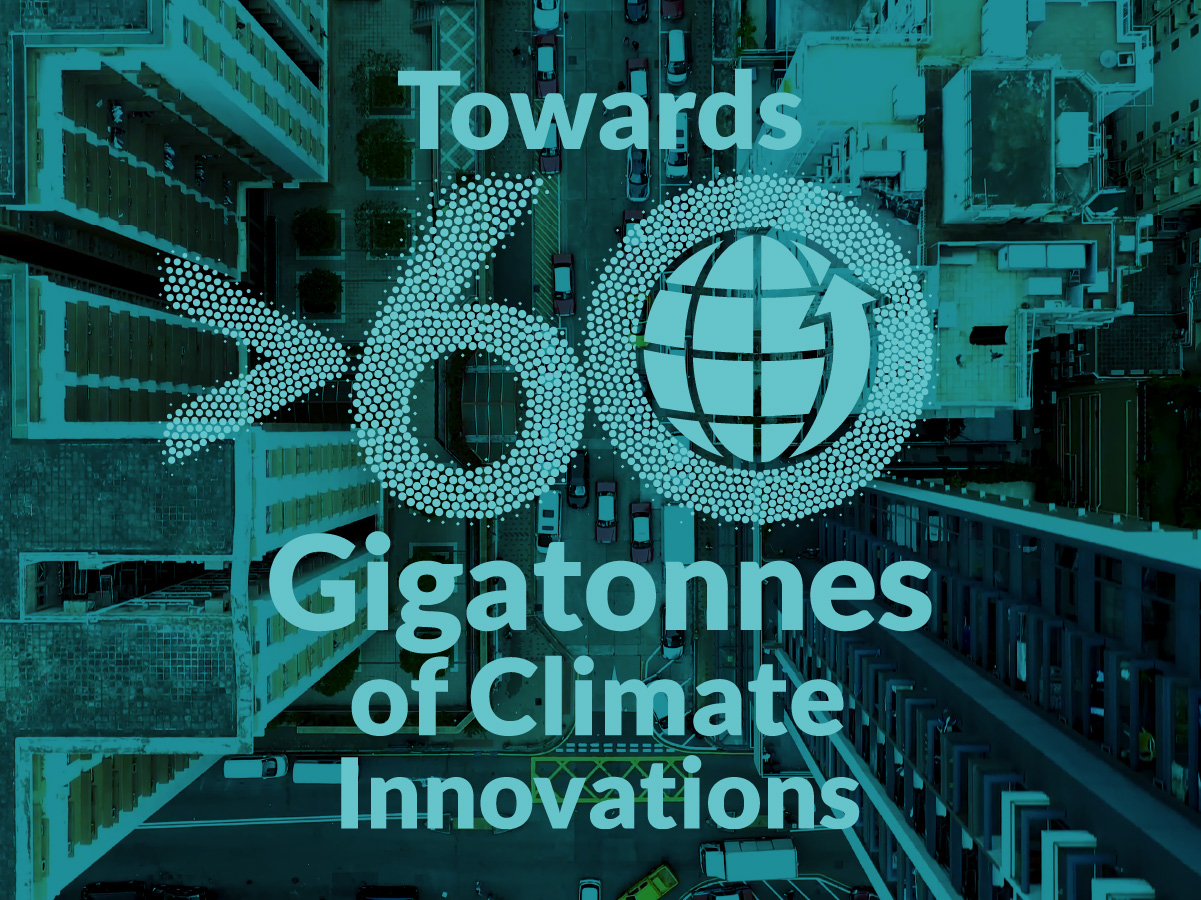Nominated innovations
1000 innovative clean energy solutions and > 150 framework enablers with the potential to deliver more than twelve gigatonnes of avoided emissions by 2030
These assessments are based on a basic avoided emission assessment. The overall concept of avoided emissions is that a solution (product or service) enables the same function to be performed with significantly less GHG emissions. The method of measuring avoided emissions, is to compare a baseline scenario without the enabling solution, with a scenario using the enabling solution; whereby the baseline represents the ‘business as usual’ (BAU) scenario.
These assessments are based on the framework document: The Avoided Emissions Framework (AEF) from September 2020

Education about sustainable waste management
Ekološka abeceda wrote: Our solution to the problem involves educating children in kindergartens and primary schools by educated persons. At the workshops, children would realize how fun recycling is and how much it would contribute to their future quality of life. In addition, they would further educate residential tenants' representatives for the proper disposal of large waste. They would inform their roommates of the proper disposal method. The other thing they would improve is the existing application. The user would receive certain discounts (such as coupons at mcdonalds) for recording properly disposed waste and scanning barcodes for recycling... Source: EIT Climate KIC's Climathon
Croatia

Ekološka abeceda
Education about sustainable waste management
Ekološka abeceda wrote: Our solution to the problem involves educating children in kindergartens and primary schools by educated persons. At the workshops, children would realize how fun recycling is and how much it would contribute to their future quality of life. In addition, they would further educate residential tenants' representatives for the proper disposal of large waste. They would inform their roommates of the proper disposal method. The other thing they would improve is the existing application. The user would receive certain discounts (such as coupons at mcdonalds) for recording properly disposed waste and scanning barcodes for recycling... Source: EIT Climate KIC's Climathon
Currently unavailable

Utilizing gravitational energy
Escalator KERS wrote: Escalators are electrically driven and average electric motor used has 100 kw. Modern escalators often use motors with frequent regulation, which significantly reduces electric consumption. But there's a situation for which conditions could be further utilized- when larger number of people is going down then up. Simple weight difference (gravitational component) can be stored in hydraulic pistons (kinetic energy recovery system- kers) for later use in the same escalator system... Source: EIT Climate KIC's ClimateLaunchPad
Serbia

Escalator KERS
Utilizing gravitational energy
Escalator KERS wrote: Escalators are electrically driven and average electric motor used has 100 kw. Modern escalators often use motors with frequent regulation, which significantly reduces electric consumption. But there's a situation for which conditions could be further utilized- when larger number of people is going down then up. Simple weight difference (gravitational component) can be stored in hydraulic pistons (kinetic energy recovery system- kers) for later use in the same escalator system... Source: EIT Climate KIC's ClimateLaunchPad
Currently unavailable

TruEarth
TruEarth wrote: At. Truearth, we produce high quality products from 100% recycled garment waste we use pre and post consumer waste we utilise 100% renewable energy for manufacturing we are a zero discharge company we save ~ 3000 litres of water / t-shirt which provides drinking water for an average adult for 3 years. We are an integrated manufacturing company with a vision to provide 100% product traceability. Our manufacturing saves 330 million litres / day of potable water enough to meet requirement of 110 million people. Our process is innovative, flexible and produces. High quality products of international standards. The company has filed 3 patents and is in the process of filing 3 more on sustainable manufacturing... Source: EIT Climate KIC's ClimateLaunchPad
India

TruEarth
TruEarth
TruEarth wrote: At. Truearth, we produce high quality products from 100% recycled garment waste we use pre and post consumer waste we utilise 100% renewable energy for manufacturing we are a zero discharge company we save ~ 3000 litres of water / t-shirt which provides drinking water for an average adult for 3 years. We are an integrated manufacturing company with a vision to provide 100% product traceability. Our manufacturing saves 330 million litres / day of potable water enough to meet requirement of 110 million people. Our process is innovative, flexible and produces. High quality products of international standards. The company has filed 3 patents and is in the process of filing 3 more on sustainable manufacturing... Source: EIT Climate KIC's ClimateLaunchPad
Currently unavailable

Thermo-electric power from cooking stoves
Heat-to-power conversion for household use in rural areas
India

Combustion Research Laboratory, Aerospace Department, IIT Bombay
Thermo-electric power from cooking stoves
Heat-to-power conversion for household use in rural areas
Currently unavailable

PR Green Solutions
Baje wrote: As a group we are made the solutions for present status q of public utility "čistoća". First we want to made better communication with costumers by showing them what work is done by "čistoća" an what costumer is actually paying. We understand that costumers do not realize how much job is done by čistoća in one day so we suggest that they improve their app and work on social media. By that costumers can actually see what job is done and what it has to be done. Second solution is to invest in promotion with domestic celebrities who can make an impact within the people and encourage them to be more responsible with trash... Source: EIT Climate KIC's Climathon
Croatia

Baje
PR Green Solutions
Baje wrote: As a group we are made the solutions for present status q of public utility "čistoća". First we want to made better communication with costumers by showing them what work is done by "čistoća" an what costumer is actually paying. We understand that costumers do not realize how much job is done by čistoća in one day so we suggest that they improve their app and work on social media. By that costumers can actually see what job is done and what it has to be done. Second solution is to invest in promotion with domestic celebrities who can make an impact within the people and encourage them to be more responsible with trash... Source: EIT Climate KIC's Climathon
Currently unavailable

Production of green methanol
Cynox wrote: One of the major green house co2 should be controlled at certain levels in the atmosphere inorder to minimise the climate change. Our technology is able to convert co2 into methanol. It is the most clean burning fuel ever known to mankind. Recycling of co2 into methanol could lead to negative emission. Methanol economy is the solution to our existing fossil fueleconomy to minimise threat of global warming. We believe that our this business model could help to achieve that... Source: EIT Climate KIC's ClimateLaunchPad
Denmark

Cynox
Production of green methanol
Cynox wrote: One of the major green house co2 should be controlled at certain levels in the atmosphere inorder to minimise the climate change. Our technology is able to convert co2 into methanol. It is the most clean burning fuel ever known to mankind. Recycling of co2 into methanol could lead to negative emission. Methanol economy is the solution to our existing fossil fueleconomy to minimise threat of global warming. We believe that our this business model could help to achieve that... Source: EIT Climate KIC's ClimateLaunchPad
Currently unavailable

Solar4Schools
Solar4Schools wrote: Solar4schools develops an automatic stand-alone solar energy system for schools in developing countries who are struggling with access to affordable and clean energy. Using mobile payments and iot technology the solar energy system is initially financed by selling phone charger services to the wider community. This subsequently provides an additional income source for the school. Furthermore, the solar4schools system enables schools to stop using kerosene and candles, so it is cleaner and enable schools to reduce carbon emission by 91% per year. The community will also benefit by not having to walk 2-10km to the town for phone charging, but rather go to the school, which in turn will place schools at the centre of the community... Source: EIT Climate KIC's ClimateLaunchPad
Norway

Solar4Schools
Solar4Schools
Solar4Schools wrote: Solar4schools develops an automatic stand-alone solar energy system for schools in developing countries who are struggling with access to affordable and clean energy. Using mobile payments and iot technology the solar energy system is initially financed by selling phone charger services to the wider community. This subsequently provides an additional income source for the school. Furthermore, the solar4schools system enables schools to stop using kerosene and candles, so it is cleaner and enable schools to reduce carbon emission by 91% per year. The community will also benefit by not having to walk 2-10km to the town for phone charging, but rather go to the school, which in turn will place schools at the centre of the community... Source: EIT Climate KIC's ClimateLaunchPad
Currently unavailable

Evacuated tube solar cooker
ETC tubes and heat exchangers which utilized solar energy for cooking appliances. Can be used indoors.
India

Sunpreet Solar Systems Private Limited
Evacuated tube solar cooker
ETC tubes and heat exchangers which utilized solar energy for cooking appliances. Can be used indoors.
Currently unavailable

WEeeCHANGE
4plus1 wrote: For our solution we decided to use a physical structure where consumers can buy or let usdispose their raee, they will receive back a 10% of their selling price. The company earns money with cultural and educational events too using sponsors for this curses. A small part of the profit comes fromdisposing raee too. To increase the ecologicalawareness of people, the companyoffers free courses in schools with the aim to shape young generations thoughts about climate changes... Source: EIT Climate KIC's Climathon
Italy

4plus1
WEeeCHANGE
4plus1 wrote: For our solution we decided to use a physical structure where consumers can buy or let usdispose their raee, they will receive back a 10% of their selling price. The company earns money with cultural and educational events too using sponsors for this curses. A small part of the profit comes fromdisposing raee too. To increase the ecologicalawareness of people, the companyoffers free courses in schools with the aim to shape young generations thoughts about climate changes... Source: EIT Climate KIC's Climathon
Currently unavailable

CaffeInk
CaffeInk wrote: Caffeink extracts pigments from coffee waste and use them to produce sustainable ink. In this way we create a new value chain. . Despite digitisation, the demand for printing ink is increasing. That ink is currently produced in a polluting way, emitting high levels of co2 and toxic compounds. What’s more, in ink, the current black color pigment used is black carbon. Recent studies found that black carbon is the second largest contributor to climate change after co2. Currently, ink is one of the most expensive liquid commodities in the world. The most expensive ingredient for ink is pigment. The total global demand for pigments is expected to grow at a rate of 4,1% to 22. 3 billion euros in 2022. ... Source: EIT Climate KIC's ClimateLaunchPad
Netherlands

CaffeInk
CaffeInk
CaffeInk wrote: Caffeink extracts pigments from coffee waste and use them to produce sustainable ink. In this way we create a new value chain. . Despite digitisation, the demand for printing ink is increasing. That ink is currently produced in a polluting way, emitting high levels of co2 and toxic compounds. What’s more, in ink, the current black color pigment used is black carbon. Recent studies found that black carbon is the second largest contributor to climate change after co2. Currently, ink is one of the most expensive liquid commodities in the world. The most expensive ingredient for ink is pigment. The total global demand for pigments is expected to grow at a rate of 4,1% to 22. 3 billion euros in 2022. ... Source: EIT Climate KIC's ClimateLaunchPad
Currently unavailable